Table of Contents
- Introduction
- Editor’s Choice
- Global Motorcycle Helmet Market Overview
- Countries with The Highest Motorbike Use
- Percentage of Motorbike Riders Using a Helmet
- Motorcyclists- By Helmet Type
- Different Motorcycle Injuries Driving the Demand for Helmets
- Motorcycle Helmet-Related Fatalities
- Violations of Motorcycle Helmet Use
- Consumer Preferences for Helmets Among Motorcyclists
- Regulations for Motorcycle Helmets
Introduction
According to Motorcycle Helmet Statistics, a helmet, is a vital safety gear for riders, with various types available, including full-face, open-face, and modular helmets, each offering different levels of protection.
They consist of an outer shell to absorb impact, an impact-absorbing liner, a comfort liner for padding, and a retention system to secure the helmet.
Safety standards such as DOT, ECE, and Snell ensure helmets meet rigorous requirements. Proper fit and maintenance are crucial, with helmets needing to fit snugly and be regularly inspected for wear and tear.
By understanding these basics, riders can prioritize safety and reduce the risk of head injuries while enjoying their rides.
Editor’s Choice
- The global motorcycle helmet market revenue is anticipated to reach USD 4.8 billion by 2033.
- Several key players dominate the motorcycle helmet market, each contributing significantly to the overall market share. HJC Europe S.A.R.L. leads the market with an 18% share.
- The Asia-Pacific (APAC) region dominates with a substantial 40.0% share, reflecting the high demand and large motorcycle user base in this region.
- The percentage of U.S. riders using a helmet decreased to 70.8% in 2019.
- The percentage of motorcyclists wearing DOT-compliant helmets increased from 64.90% in 2021 to 66.50% in 2022, indicating a growing preference for helmets that meet safety standards.
- It was found that 43.30% of the public consistently wears a helmet while driving.
- Price is a significant consideration, with 37.78% strongly agreeing and 35.00% agreeing that it affects their decision.
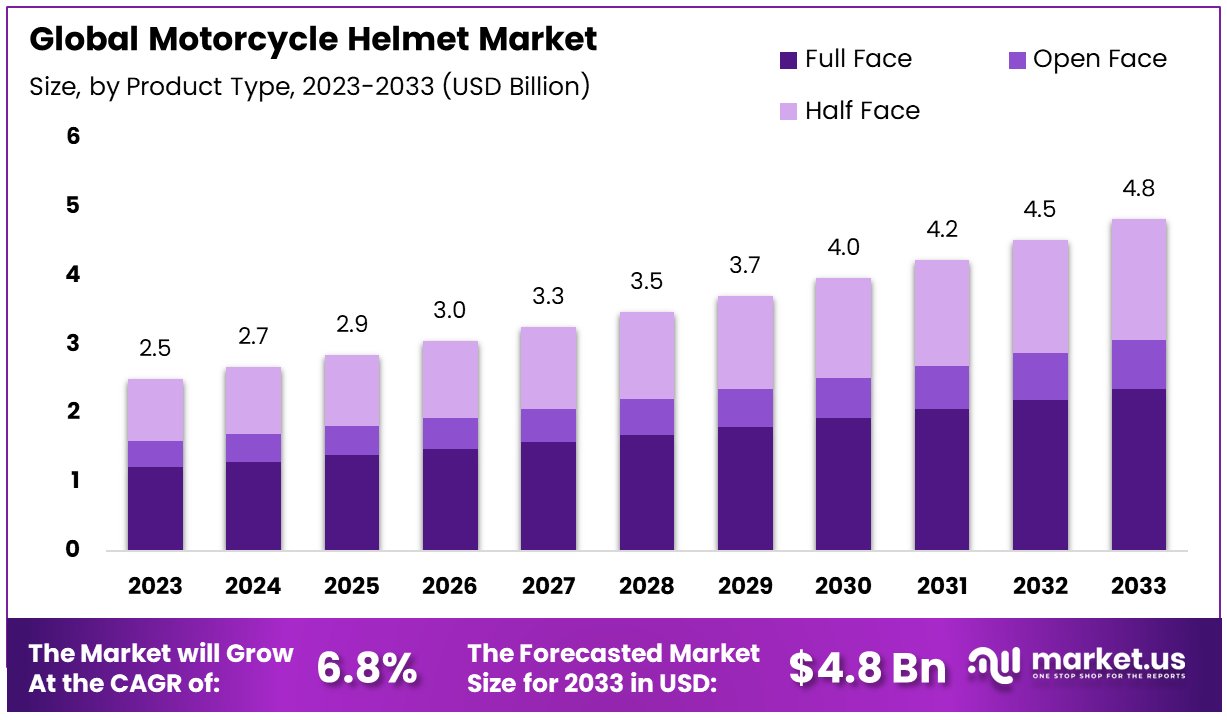
Global Motorcycle Helmet Market Overview
Global Motorcycle Helmet Market Size
- The global motorcycle helmet market has demonstrated consistent growth over the past decade at a CAGR of 6.80%, with revenue figures reflecting a steady upward trend.
- In 2023, the market revenue stood at USD 2.5 billion.
- Looking ahead, the market is forecasted to reach USD 4.2 billion by 2031, USD 4.5 billion by 2032, and USD 4.8 billion by 2033.
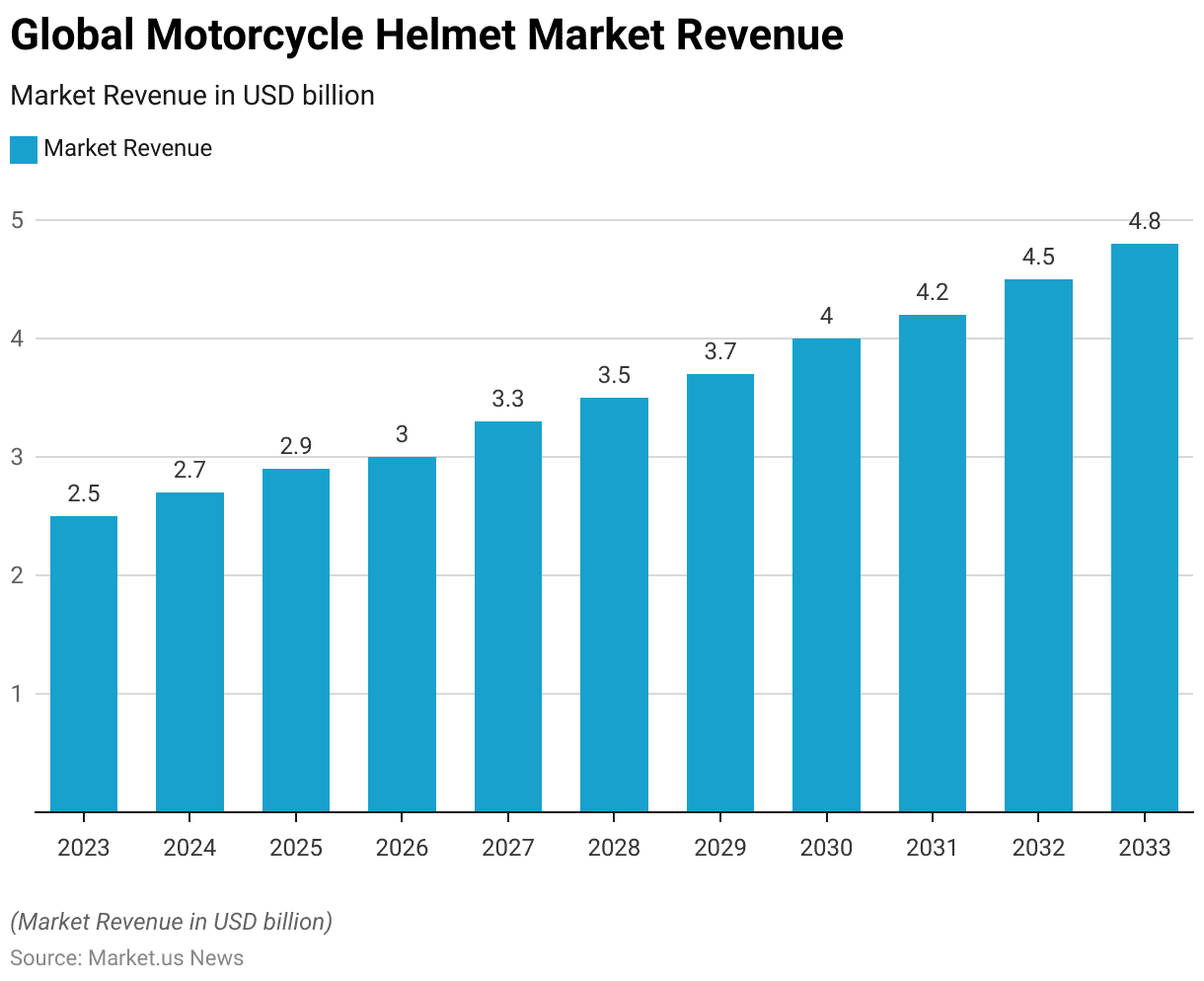
Competitive Landscape of the Global Motorcycle Helmet Market
- Several key players dominate the motorcycle helmet market, each contributing significantly to the overall market share.
- HJC Europe S.A.R.L. leads the market with an 18% share, followed closely by Dainese SpA at 17%.
- Shoei Co. Ltd and Arai Helmet Ltd hold 9% and 8% of the market, respectively.
- Schuberth GmbH also commands an 8% share, while BELL HELMET captures 7%.
- Both AGV and Suomy each contribute 6% to the market.
- Other key players hold the remaining 2% of the market.
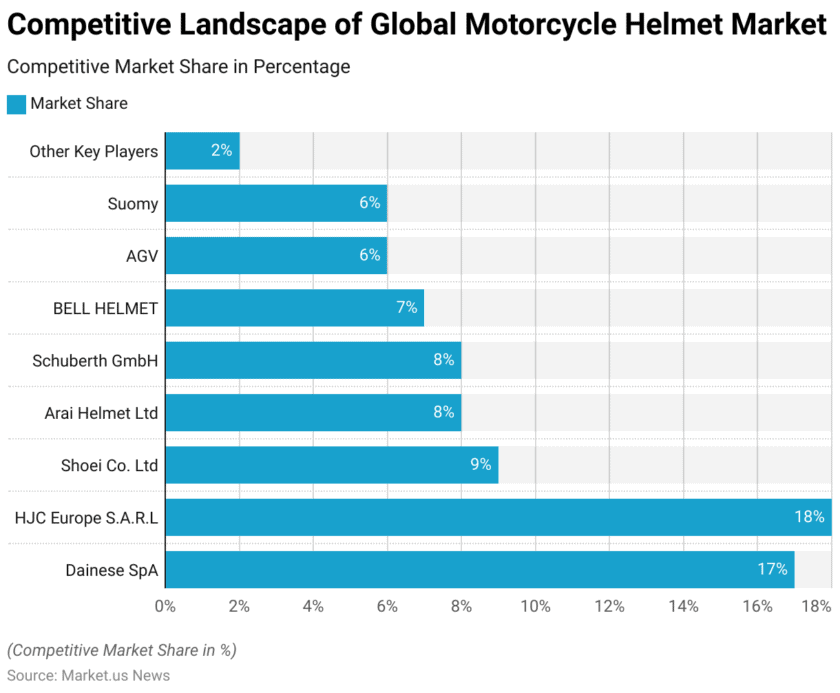
Regional Analysis of the Global Motorcycle Helmet Market
- The global motorcycle helmet market exhibits a diverse regional distribution of market shares.
- The Asia-Pacific (APAC) region dominates with a substantial 40.0% share, reflecting the high demand and large motorcycle user base in this region.
- North America follows with a 22.0% market share, indicating significant market penetration and consumer awareness regarding helmet safety.
- South America holds a 16.0% share, while Europe accounts for 12.0% of the market.
- The Middle East and Africa (MEA) region contributes 10.0% to the overall market share.
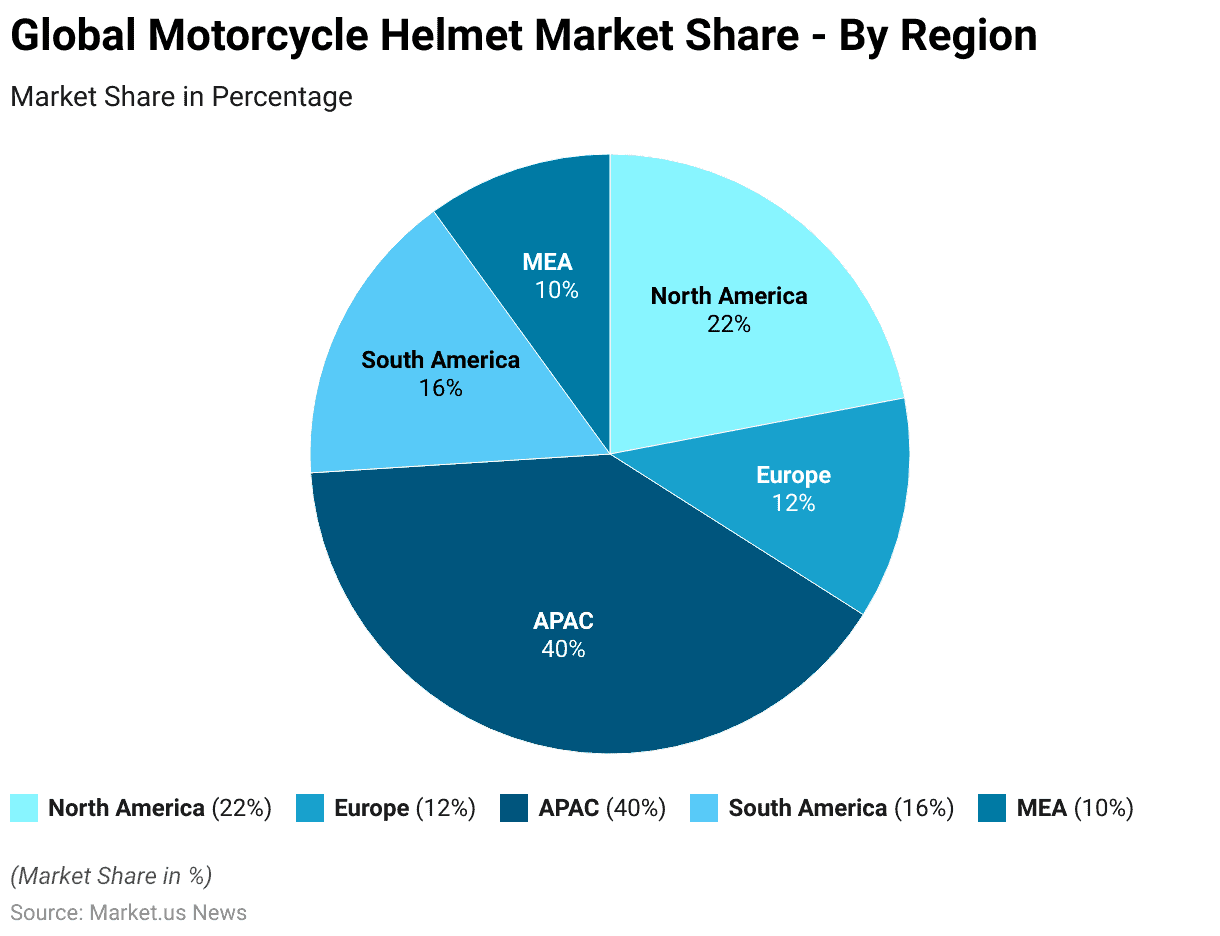
Countries with The Highest Motorbike Use
- Motorbike ownership varies significantly across countries, with the highest percentages observed in Southeast Asia.
- Thailand leads with 87% of households owning a motorbike, closely followed by Vietnam at 86% and Indonesia at 85%.
- Malaysia also shows a high ownership rate of 83%.
- In China, 60% of households own a motorbike, while India and Pakistan have 47% and 43% ownership, respectively.
- In Nigeria, 35% of households own a motorbike, and the Philippines follows with 32%.
- In Brazil and Egypt, motorbike ownership stands at 29% and 28%, respectively.
- Italy has 26% of households owning a motorbike, slightly higher than Tunisia at 25%.
- In Argentina and Colombia, 24% and 23% of households own a motorbike, respectively.
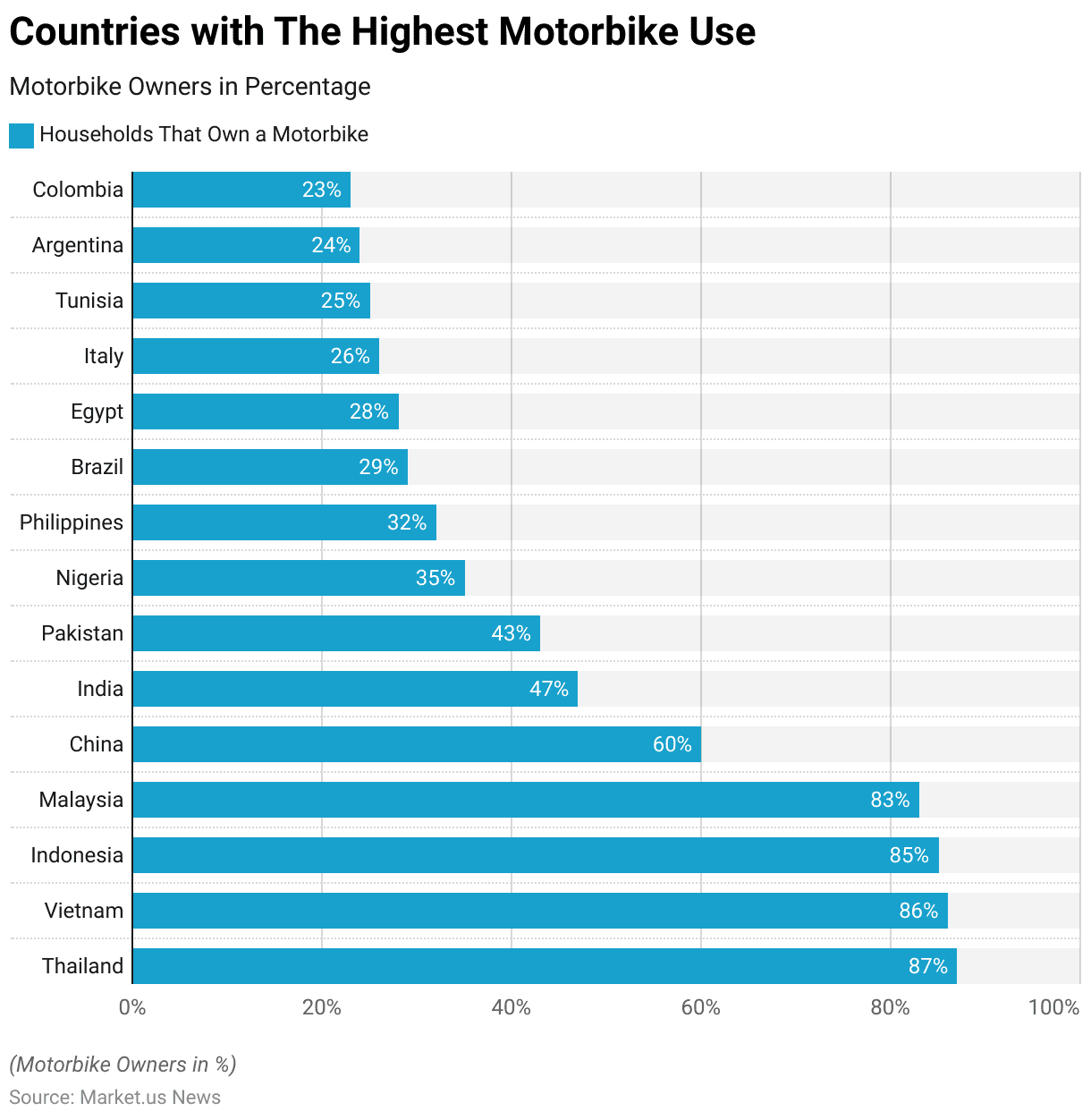
Percentage of Motorbike Riders Using a Helmet
- The percentage of U.S. riders using a helmet has shown fluctuations over the past decade.
- In 2010, helmet usage was at 54.3%, which increased significantly to 66.5% in 2011.
- A notable improvement occurred in 2018, with helmet usage climbing to 71.0%, slightly decreasing to 70.8% in 2019.
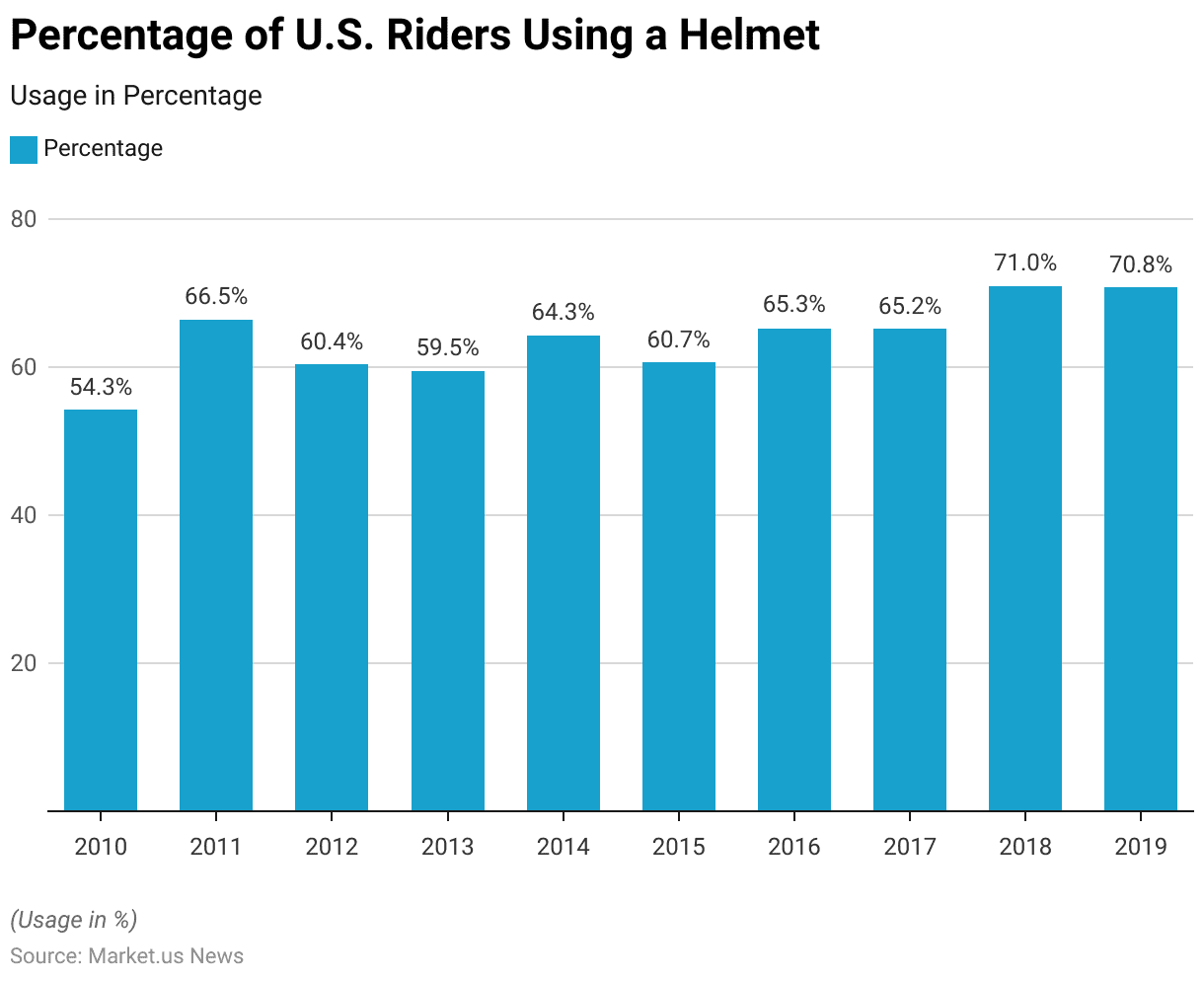
Motorcyclists- By Helmet Type
- In the comparison of helmet usage among motorcyclists between 2021 and 2022, there has been a noticeable shift.
- The percentage of motorcyclists wearing DOT-compliant helmets increased from 64.90% in 2021 to 66.50% in 2022, indicating a growing preference for helmets that meet safety standards.
- Conversely, the usage of non-compliant helmets rose from 5.70% to 9% over the same period.
- There was also a decline in the number of motorcyclists not wearing helmets at all, decreasing from 29.40% in 2021 to 24.50% in 2022.
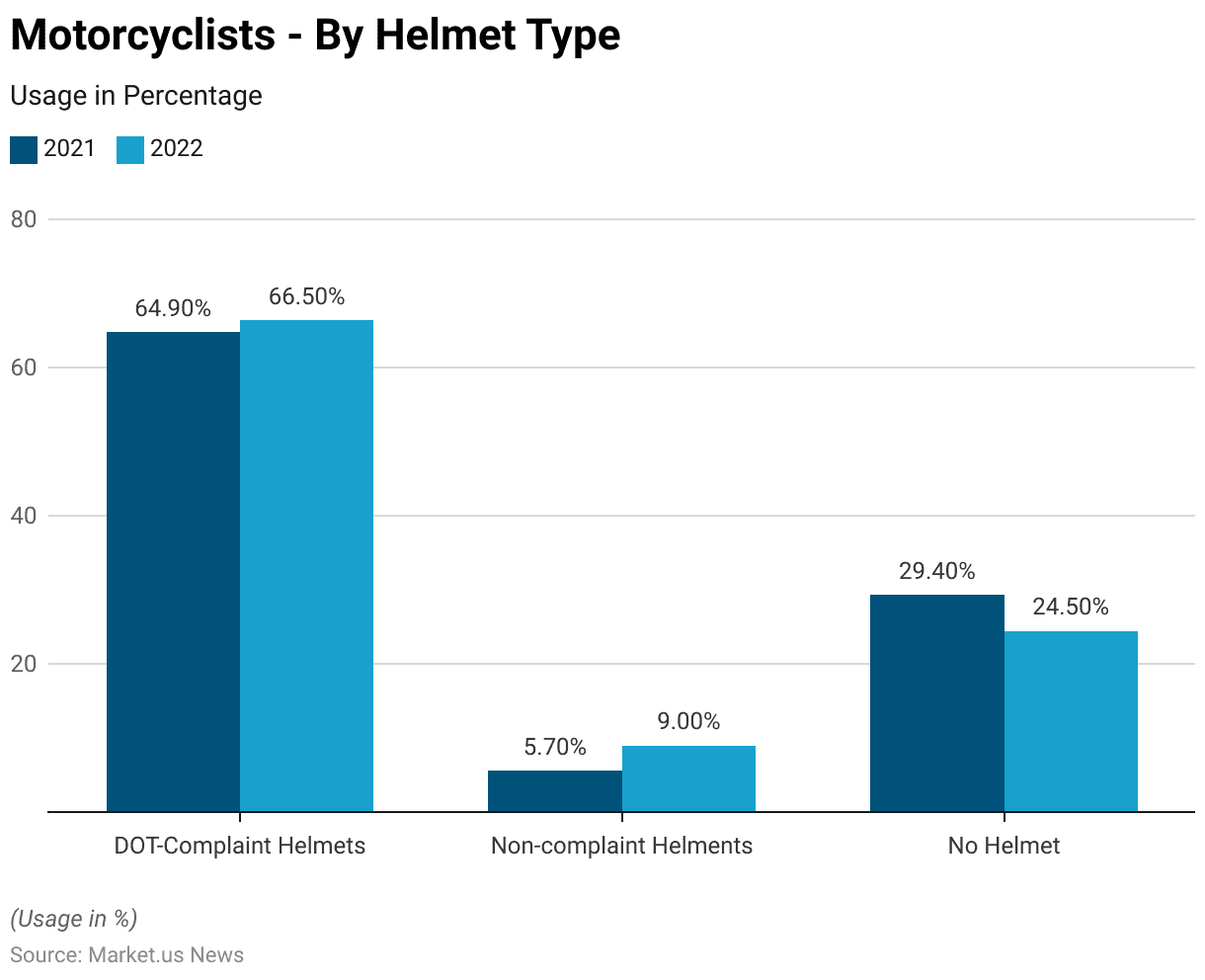
Different Motorcycle Injuries Driving the Demand for Helmets
- Motorcycle riding carries undeniable risks, as riders face significantly higher fatality and injury rates compared to other drivers.
- In the United States in 2021, 83,000 motorcyclists were injured, averaging 468 injuries per 100 million vehicle miles traveled.
- A concerning factor is the involvement of unlicensed riders, contributing to 36% of fatal motorcycle accidents.
- These incidents vary throughout the year, with August being the most dangerous month, accounting for 12% of fatal crashes, while January is the safest at 3%.
- Despite motorcycles comprising only 3% of registered vehicles, they are involved in 14% of all traffic fatalities and cause 3% of injuries to vehicle occupants.
Motorcycle Helmet-Related Fatalities
- The failure of the 2023 subcommittee bill brought relief to safety advocates in the U.S.
- In 2021, there was a record-breaking 6,084 motorcycle fatalities, a 21% surge from 2019, comprising 14% of all motor vehicle accident deaths, nearly three times the 1997 figure.
- Helmets were credited with saving 1,872 lives, with an estimated 749 additional lives that could have been saved if all riders wore helmets.
- Helmet usage led to a 37% reduction in motorcyclist fatalities and a 41% reduction in passenger fatalities.
- Despite motorcycles representing only 3% of registered vehicles, they accounted for 14% of traffic fatalities, with motorcycle crashes resulting in 18% of occupant deaths and 4% of occupant injuries.
- In 2017, helmet compliance was 65.2%, rising to 87% in states with mandatory laws and dropping to 43.7% in others.
- Fatality helmet usage rates varied in 2018, from 89% in states with universal laws to 26% in states without helmet laws.
Violations of Motorcycle Helmet Use
- Violations of helmet use among riders and pillion riders per 100 person-minutes of observation reveal significant non-compliance.
- Among riders, 6.9 violations were recorded for not wearing a helmet, compared to 17.9 violations among pillion riders, resulting in an overall rate of 12.4 violations.
- The use of non-standard helmets was observed in 27.1 riders and 14.5 pillion riders, with a total of 20.8 violations.
- Violations for not wearing a full-face helmet were 6.8 for riders and 5 for pillion riders, averaging 5.9.
- Improper helmet use was noted in 15.8 riders and 7.7 pillion riders, culminating in 11.8 violations.
- Lastly, ineffective helmet use was observed in 21.5 riders and 12 pillion riders, totaling 16.7 violations.
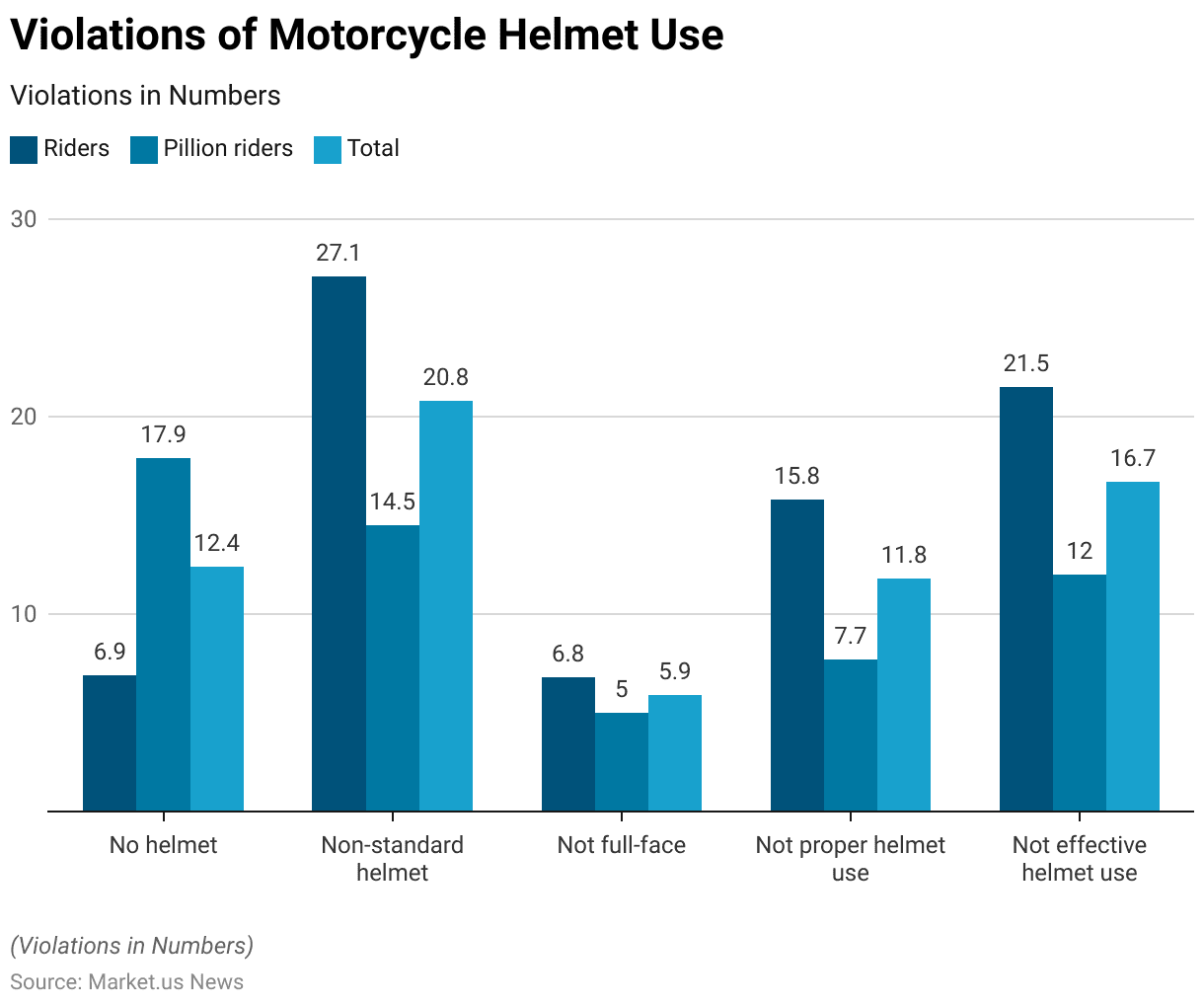
Consumer Preferences for Helmets Among Motorcyclists
Habits of Using Helmet
- It was found that 43.30% of the public consistently wears a helmet while driving.
- Additionally, 38.40% of individuals have the habit of wearing a helmet only at certain places.
- Meanwhile, the remaining 18.30% use a helmet exclusively when driving for adventure purposes.
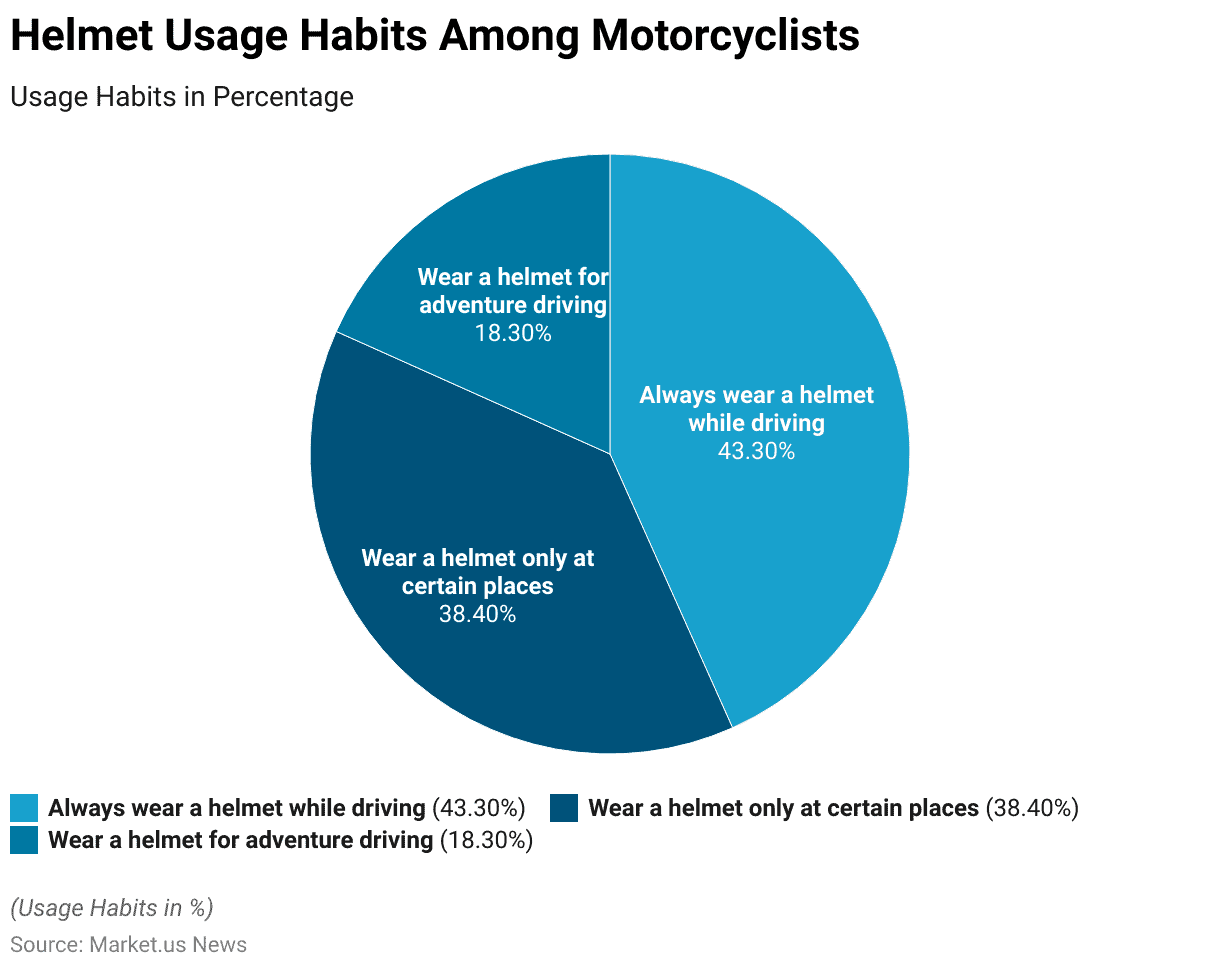
Factors Influencing the Choice of Helmet or While Purchasing a Helmet Among Motorcyclists
- Various factors influence motorcyclists’ choices when purchasing a helmet.
- Price is a significant consideration, with 37.78% strongly agreeing and 35.00% agreeing that it affects their decision.
- Suitable color according to gender is important to 35.56% who strongly agree and 32.78% who agree. Brand name is also influential, with 36.11% strongly agreeing and 32.22% agreeing.
- The helmet’s availability in the market is crucial, as 40% strongly agree and 41.11% agree.
- The easy eject helmet removal system is highly valued, with 48.33% strongly agreeing and 40.56% agreeing.
- Reflective material is another key factor, with 37.22% strongly agreeing and 35.00% agreeing.
- Design influences 31.67% who strongly agree and 33.89% who agree.
- Comfort level is paramount, with 66.67% strongly agreeing.
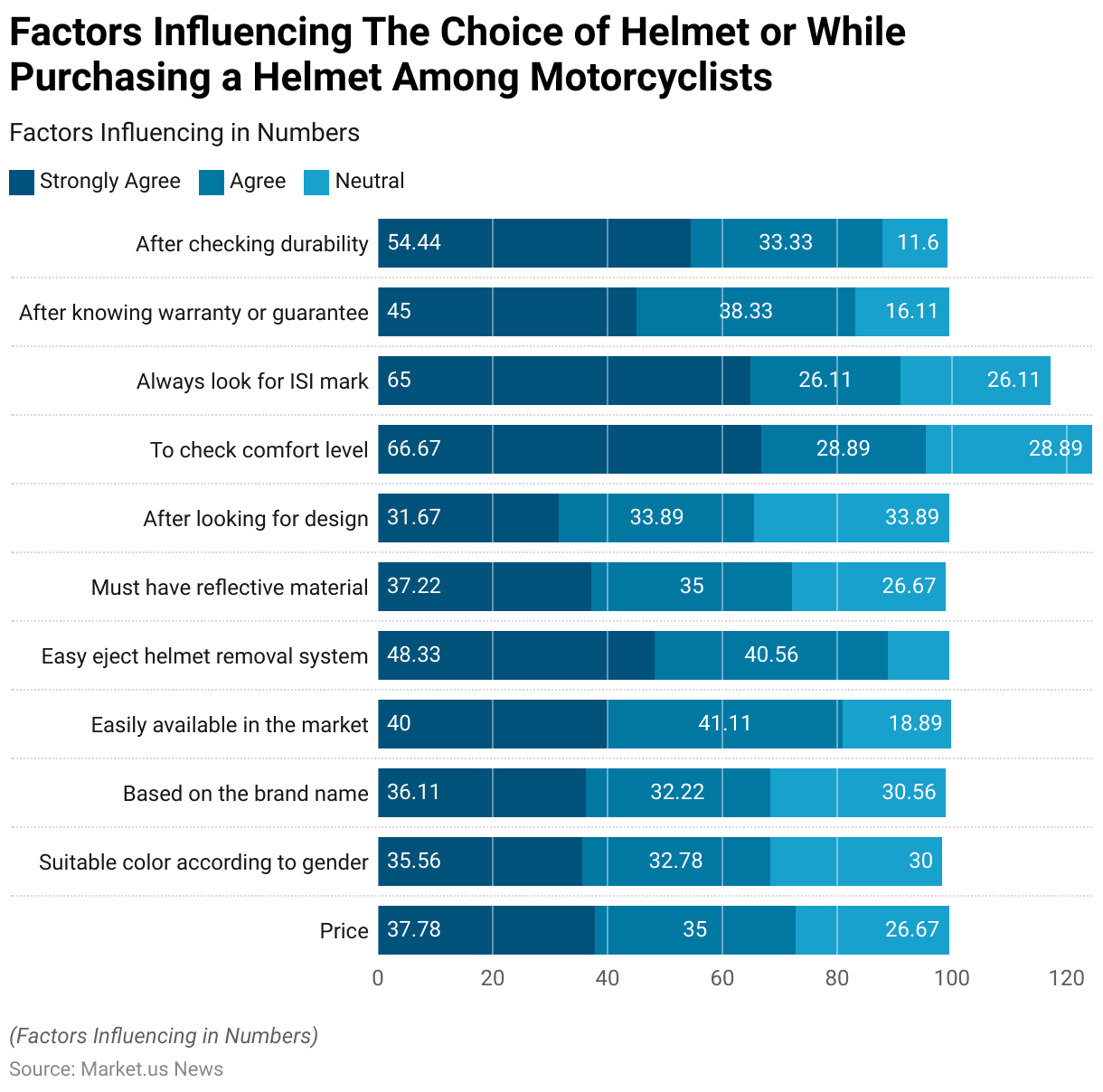
Regulations for Motorcycle Helmets
- Regulations for motorcycle helmets vary by country, ensuring rider safety through different standards and requirements.
- In the United States, the Department of Transportation (DOT) mandates helmets meet FMVSS 218 standards, which focus on impact protection.
- Additionally, the Snell Memorial Foundation provides voluntary but more rigorous standards for higher safety assurance.
- In Europe, the Economic Community Europe (ECE) 22.06 standard has replaced the older 22.05 standard, emphasizing rotational impact protection and more stringent testing for durability and visor safety.
- Countries like France, Italy, and Germany require all motorcycle helmets to comply with the ECE 22.06 standard.
- Meanwhile, in Japan, helmets must meet the Japanese Industrial Standards (JIS).
- In Australia, the Australian/New Zealand Standard (AS/NZS) 1698-2006 is mandatory.
Discuss Your Needs With Our Analyst
Please share your requirements with more details so our analyst can check if they can solve your problem(s)





